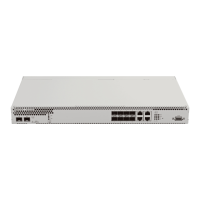4.4 Switch operation modes
The device can operate in two modes—standalone mode and stackable mode. In stackable mode,
multiple switches of the same model can be combined in a stack and work as a single device. By default,
MES3000 switches operate in standalone mode.
4.4.1 Switch operation mode selection
Switch operation mode selection is located in the stack management menu (startup menu item no.
[5]).
Startup Menu
[1] Download Software
[2] Erase Flash File
[3] Password Recovery Procedure
[4] Set Terminal Baud-Rate
[5] Stack menu
[6] Back
Enter your choice or press 'ESC' to exit:
Item no. [3]—switch operation mode selection ([1]—standalone mode, [2]—stackable mode):
Stack menu
[1] Show unit stack id
[2] Set unit stack id
[3] Set unit working mode
[4] Back
Enter your choice or press 'ESC' to exit:
4.4.2 Switch operation in stackable mode
MES3000 stack works as a single device and can include up to 8 devices with the following roles
defined by their sequential number (UID):
Master (device UID 1 or 2)—manages all devices in a stack.
Backup (device UID 1 or 2)—device, controlled by master. Replicates all settings, and takes on stack
management functions in case of the master device failure.
Slave (device UID 3 or 8)—device, controlled by master. Can't work in standalone mode (without
master device).
In stackable mode, MES3124/MES3124F and MES3224/MES3224F use XG3 and XG4 ports for
synchronization; also, these ports are not used for data transmission. MES3108/MES3108F and
MES3116/MES3116F use only XG2 port for synchronization; also, this port is not used for data
transmission. The following two topologies exist for synchronization devices—ring and chain. It's
recommended to use the ring topology for increased stack robustness.

